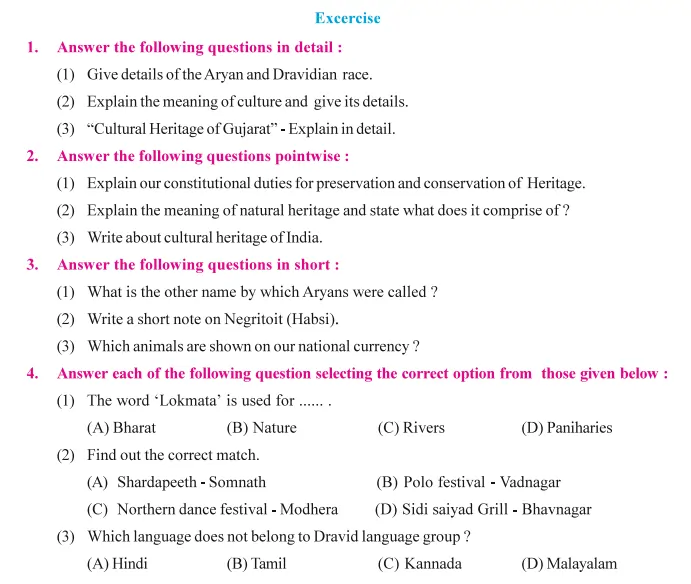We have create full chapter 1 Heritage Of India Notes now we are making Solution. You can get the complete exercise solution with easy to learn answer.
We have also added extra question that has appear in last year papers. After this you do not have to find Digest or Guide for Heritage Of India Solution.
We are leading student welfare website, therefore we are trying to provide the best book solutions. Learn, make notes, share with your friends.
GSEB Heritage of India Exercise Solution

Gujarat Board Class 10 Social Science Chapter 1 Heritage Of India Exercise contains 4 set of questions: Details, Point Wise, In short and MCQs.
We have provided each question answer in easy to learn and taking notes.
Q1. Answer the following question in detail.
Give detail of the Aryan and Dravidian Culture.
The Dravidians:
Origin and Civilization: Dravidians originally belonged to India and were direct descendants of the Stone Age civilization. They created the Mohenjodaro culture.
Identity and Language: The tribe that came to India from the north later became known as Dravidians. They had their own language and culture.
Influence on Indian Beliefs: Dravidians introduced the concept of mother as a “Goddess” and father as a ‘God,’ leading to the development of Parvati and Shiva as mother and father figures in Indian culture. They also initiated the tradition of worshipping nature, animals, and using ‘dhup’ (incense stick), ‘deep’ (lamp), and ‘aarti.’
Deities and Cultural Exchange: Dravidians believed in deities, and the Aryans accepted these deities as their own, leading to a fusion of cultures.
Influence and Progress: Over time, Dravidians got influenced by Aryan culture, resulting in inter-caste marriages. They had matriarchal (i.e. woman as the head) system of family. They excelled in various crafts and arts, like boat-making, weaving, spinning, and dyeing.
Migration to South India: As Aryan dominance increased, Dravidians migrated to South India and settled there. The people of South India are considered Dravidians and speak Dravidian languages such as Tamil, Telugu, Kannada, and Malayalam.
The Aryans:
Origin and Civilization: Nordic-Aryans created the Aryan civilization in India. They were known as Hindus in ancient times.
Homeland and Region: The northwest area where they were densely populated was called ‘Aryavarta,’ also known as ‘Sapta Sindhu’ due to the seven rivers flowing in the region. Their territory extended up to Mithila in the east and Vindhyachal in the south during the post-Vedic period.
Development and Names: Aryans were the most advanced among the tribes, and their vast region had various names like Bharatbhumi, Bharatkhand, and Bharat Varsha, attributed to the king Arya Bharat or Bharat tribe.
Nature Worship and Hymns: Aryans were nature lovers and worshipped trees, rivers, mountains, sun, wind, and rain. They composed hymns for praying to these natural elements.
Religious Practices: India learned specific religious ceremonies like recitation of Vedas and performing Yagyas from the Aryans.
Explain the meaning of culture and give its details.
Meaning Of Culture
- Culture is how people live their lives and includes habits, values, customs, and traditions.
- It’s a sum of behavioral patterns and interactions within societies.
- This knowledge is passed down through generations.
- Culture encompasses traditions, beliefs, and capabilities acquired as part of a society.
Examples of Culture
- Hindu culture, culture of Gujarat, American culture, etc.
“ Cultural Heritage of Gujarat”- Explain in detail.
Gujarat in India that has a lot of different and valuable cultural traditions. Here are some important things that show how special Gujarat’s culture is:
(A) Places having cultural, legendary and archaeological importance:
- Lothal (Dholka Taluka)
- Rangpur (Limdi taluka in Surendranagar district)
- Dholavira (Kachchh district)
- Rozadi or Shrinathgadh (Rajkot district).
(B) Important tourist spots having historical values:
- Victory tower of Vadnagar
- Stone inscription of King Ashoka at Junagadh
- Sun Temple of Modhera
- Gate of Champaner
- Rudra Mahalaya of Siddhpur
- Mansar Lake of Viramgam
- Jama Masjid (Ahmedabad)
- Jhoolta Minara (Shaking towers) Ahmedabad
- Sidi Saiyed Jali (Ahmedabad)
- Hathisinh temple (Ahmedabad)
- Sahastralinga lake of Patan
- Rajmahal of Vadodara
- Tomb of Mohabat Khan
(C) Places having religious importance:
- Parsi agiyari of Navsari
- Dwarkadhish temple of Dwarka
- Shardapeeth of Jagadguru Shankaracharya
- Somnath temple which is one of the 12 Jyotirlingas.
- Ambaji in north Gujarat (Banaskantha District)
- Bahucharaji temple (Mehsana district)
- Ranchhodrai temple in Dakor (Kheda district)
- Shamlaji (Aravalli district)
(D) Well known religious, social and tourist places and events:
- Polo forest in Vijayanagar (Sabarkantha district)
- Kite festivals
- Kankaria carnival (Ahmedabad)
- Tana-Riri festival (Vadnagar)
- Northern dance festival (Modhera)
- Rannotsava (Kachchh district).
(E) Jain and Buddhist tourist places:
- Jain and Buddhist caves can be seen at various places of Gujarat.
- Some of them are at Vadnagar, Taranga, Khamb- haliya, Shamlaji, Koteshwar, Talaja, Dhank, and Jhagadiya.
Q2. Answer the following questions pointwise.
Explain our Constitutional duties for preservation & conservation of heritage.
Constitutional Duties for Heritage Preservation and Conservation:
- Cultural Treasure: India’s heritage is a blend of cultures, art, trade, and history spanning thousands of years.
- Diverse Beauty: This heritage is diverse, attractive, and a source of national pride and global recognition.
- Glory and Prosperity: Our culture and heritage have contributed to our national success and global reputation.
- Moral Responsibility: It is our duty to protect and safeguard our heritage due to its significance.
- Citizen Engagement: All citizens must ensure the preservation of ancient monuments and sites of historical value.
- Constitutional Mandate: Article 51(A) of the Indian Constitution lists fundamental duties for citizens.
- Specific Duties: Clauses (6), (7), and (9) highlight duties related to heritage preservation:
- Recognize and preserve our harmonious culture and its value.
- Maintain natural surroundings like forests, rivers, and wildlife with compassion.
- Safeguard public property and reject violence.
By fulfilling these duties, we can safeguard our rich heritage for present and future generations.
Explain the meaning of Natural Heritage of India and state what does it comprise of?
Natural Heritage of India:
- Definition: Natural heritage refers to the entire collection of biodiversity elements, which includes plants, animals, ecosystems, and geological formations.
- Diverse Variety: India’s natural heritage is distinctive and varied. It encompasses mountains, forests, deserts, rivers, oceans, as well as a wide range of plants, animals, and landscapes.
- Essential Resources: This heritage provides essential resources such as food, water, and clean air, supporting our basic needs and well-being.
- Cultural Significance: India has a long-standing tradition of respecting and worshiping nature, evident in ancient texts like ‘Panchatantra’ and ‘Jataka Tales’. Nature has been closely intertwined with our culture.
- Artistic Influence: Our ancestors have used nature’s rhythms to create classical and folk music, with various musical scales based on different times of the day.
- Medicinal Wisdom: Ancient medical practices like Ayurveda, Unani, and Naturopathy are rooted in nature, highlighting our historical connection to natural remedies and healing.
- Strong Bond: India’s rich natural heritage reflects a strong and deep connection with nature, shaping our culture, arts, and traditional knowledge.
Write about cultural heritage of India.
India’s Cultural Heritage:
- India has a diverse and rich heritage that it has shared with the world.
- Cultural heritage includes things made by humans using their skills and wisdom.
- Many different groups like Aryans, Mughals, Britons, and more contributed to India’s culture over time.
- Indian architecture and sculpture date back over 5000 years, seen in Indus Valley Civilization remains.
- Statues of gods, animals, toys, and intricate sculptures showcase our heritage.
- Historical artifacts like Mauryan Era’s figures, Buddhist statues, Jain sculptures, and Rashtrakuta dynasty’s Ellora caves highlight our rich culture.
- Our heritage encompasses structures like palaces, temples, forts, and important freedom movement sites.
- Places like Sabarmati Ashram and Shantiniketan are part of our cultural heritage.
Enriching Cultural Heritage:
- Our heritage is enriched by languages, scriptures, the discovery of zero, mathematics, and calendars.
- Astronomy, iron structures, literature, religion, and ancient chariots contribute too.
- Political science, zoology, botany, Vastu shastra, and environmental protection are also part of it.
- Our culture includes the concept of republic systems, judiciary, legislation, and yuddhashastra (war strategies).
Q3. Answer the following questions in short.
Aryans were sometimes called Nordic-Aryans. They were from a place called Aryavrata and were also known as Aryavrats.
Negritoit or Negrose people were the earliest inhabitants of India. They came from Africa through Baluchistan. They were black, had curly hair, and were about 4-5 feet tall.
Our currency features the National Emblem symbol. This symbol includes a horse on the left, a bull on the right, and the Ashoka Chakra in the center. Four Indian lions stand back to back on the circular base of the emblem.
Q4. Answer each of the following questions by selecting the correct option from those given below:
Answer: Rivers | Northern Dance Festival-Modhera | Hindi

